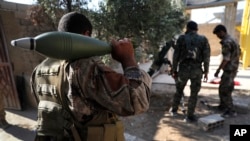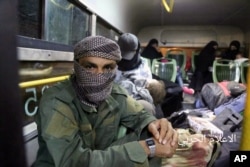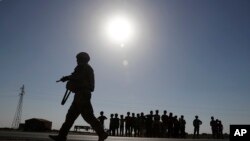The latest phase in the long-running Syrian conflict is presenting a dizzying picture of strange bedfellows and temporary battlefield deals as sectarian groups, President Bashar al-Assad and overseas powers, including the United States, Russia and Iran, maneuver to gain an edge or to steer the war to a resolution.
U.S. officials said this week that Turkish-backed Syrian rebels fired on American troops who were working with the Kurdish-led Syrian Democratic Forces in northern Syria. The Turks view America’s ground ally against Islamic State, the Kurdish People’s Protection Units, or YPG, as much a menace to them as the jihadists, and anti-Assad rebels have long seen the YPG as serving Assad’s interests.
Adding to the confusion of opportunistic maneuvers, Assad and his foreign Shi’ite backers, Iranian-directed militias and Hezbollah, granted more than 600 IS fighters and their families safe passage this week from the west to the east of Syria after the jihadists suffered a defeat in the Qalamoun mountains, on the border with Lebanon.
The transfer deal for the militants, which included a Syrian government escort from near Damascus to Deir ez-Zor, prompted angry condemnations from the Syrian Coalition, the umbrella political organization of anti-Assad rebels, but scant public comment from Western powers in the anti-IS coalition.
Although U.S. envoy to the anti-IS international coalition Brett McGurk tweeted a rebuke Thursday (Aug. 24), “Irreconcilable #ISIS terrorists should be killed on the battlefield, not bused across #Syria to the Iraqi border without #Iraq’s consent.”
After the Iraqi government issued a furious condemnation of the transit of IS militants, the Pentagon issued a statement saying, "the Coalition was not a party to any agreement between the Lebanese Hezbollah, the Syrian regime and ISIS."
A Syrian rebel statement said the safe-passage deal “exposed the close links between ISIS, the Iranian-backed Hezbollah and the Assad regime.” But for analysts, the deal smacked more of expediency, a move by Assad and Hezbollah to solve a problem on the border with Lebanon. But it earned the Syrian government no favors from IS militants in Raqqa province, who launched an offensive on Syrian government forces, seizing tanks and rockets.
Creating a negotiating base
The war, which has left up to a half-million dead and millions of Syrians displaced, has been notorious for double-dealing.
At the beginning of the rebellion against Assad, the beleaguered Syrian leader freed hundreds of jailed jihadists. Syrian rebels argue the mass release was part of an Assad plan aimed at infiltrating insurgent ranks with extremists so the Syrian dictator could later claim he was battling an uprising by terrorists, not an insurgency of moderates wanting democracy.
In this latest phase the dangers of miscalculation by all sides as they jostle for advantage may be mounting.
Charles Lister, an analyst with the Middle East Institute, a Washington policy research organization, argues the current maneuvering reflects “the shifting priorities of external states” who are “driving the creation of an interim set of pre-settlement conditions,” to split the wrecked country into territorial zones of control.
The map is becoming increasingly clear with Assad and his Iran-commanded Shi’ite allies controlling the west and central desert area, the U.S.-backed Kurds the northeast of the country, with IS boxed in in the east and anti-Assad rebels bottled up in northern Idlib province and a small part of the south.
US, Russia
In recent weeks cooperation between the United States and Assad’s other foreign backer, Russia, has deepened, according to U.S. officials, as both Washington and Moscow strive to avoid conflict between their own militaries and between their proxies.
The two powers have established a "co-operation center" in neighboring Jordan, have worked to get the Syrian military and rebel factions in the southwestern city of Dara'a to observe a cease-fire and have collaborated in northern Syria to try to prevent clashes between SDF forces and Turkish-backed rebels. And Washington and Moscow have been co-operating to ensure that de-escalation zones, agreed to by Russia, Turkey and Iran, remain free of fighting.
Trump administration officials have made it clear their priority in Syria is the defeat of IS and not the ouster of Assad. But critics claim that has meant ceding Syria to Iran, which controls tens of thousands of troops in the war-torn country, and argue it diminishes U.S. influence in the region. “Hezbollah is immeasurably more powerful than before the Arab Spring,” argues Lister.
The situation also worries Israel, which fears Iran and Hezbollah will use Syria to launch a future Shi’ite conflict with Israel. Last week, Israeli Prime Minister Benjamin Netanyahu met with Russian President Vladimir Putin in Sochi, where the Israeli leader condemned Iran’s strength in Syria, saying it is “endangering us [Israel], and in my opinion, endangering the region,” according to his officials.
“It still isn't clear how (U.S. President Donald) Trump intends to counter Iranian influence,” says Daveed Gartenstein-Ross, an analyst at the Foundation for the Defense of Democracies, a Washington research organization. “One of the problems for U.S. policy has been that weakening Iran in Syria will likely strengthen the hand of jihadist groups,” he added.







